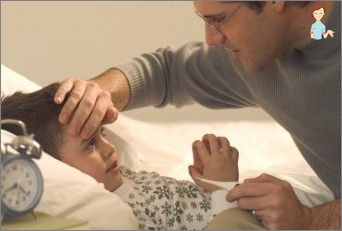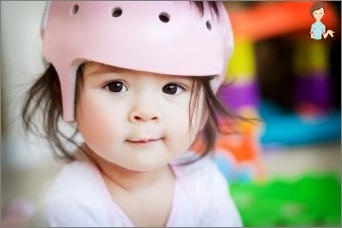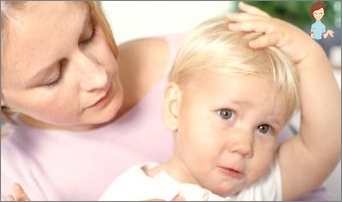Intracranial pressure: symptoms and signs
What symptoms indicate increased intracranial pressure in children of different ages? When the hydrocephalus is diagnosed?
A child or an adult intracranial pressure – the value is non-permanent. The brainstant is covered with 3 shells that protect against external traumatic influences – solid, web and soft – and participating in the blood supply to this important organ.
Anatomy
In the assignment fossa and side sections of the brain there are cranial fossa performing the role «Tanks – The spinal fluid is accumulated there – Likvor.
 Between the sputum shell and solid there are subparent spaces, which are also filled with a spinal fluid, washing the outer surface of the brain.
Between the sputum shell and solid there are subparent spaces, which are also filled with a spinal fluid, washing the outer surface of the brain.
The liquor formed by vascular plexuses of the ventricular system creates an immunological barrier, performs transport and excretory functions. Likvor always moves: wash the spinal and brain, absorbed again into the blood through venous sinuses.
His movement and creates intracranial pressure. It depends on the exchange processes and the number of accumulated spinal fluid.
If the outflow makes it difficult, the increased intracranial pressure is diagnosed. The child changes behavior and deteriorates the general condition.
Intracranial hypertension
Causes of incremental pressure in children:
- brain tumors of different etiologies – a brain tumor is formed, which reduces the space in which the liquor moves;
- meningitis or encephalitis – toxic swelling appear, the fluidity of the spinal fluid changes, its outflow is broken;
- Hemato-brain injuries – intracranial hematoma also causes cerebral edema;
- Intrabile hemorrhage and ischemic brain circulation disorders.
In breast babies, the outflow of the spinal fluid may be difficult due to the anatomical anomalies of the building of the bone and vascular system, due to hypoxia during pregnancy and during difficult labor, when infected with intrauterine infection, with the early battle of the bones of the skull – the brain continues its growth, And there is nowhere to grow.
Signs of intracranial pressure in a child
Symptoms of increasing intracranial pressure in children differ depending on their age.
- The babies head becomes disproportionately big, especially in the forehead.
 Periodically, or constantly swelling the spring – the area on the darkness of a small child, in which the bones are shifted during childbirth. In a healthy baby, the skin at this place is smooth or even slightly sprawling.
Periodically, or constantly swelling the spring – the area on the darkness of a small child, in which the bones are shifted during childbirth. In a healthy baby, the skin at this place is smooth or even slightly sprawling.- There is a significant lag in physiological development compared with the peers.
- Appear: unstable behavior, frequent crying, increased capriciousness, restless sleep, frequent jumping, poor appetite.
- Loss occurs, which is periodically replaced by emotional excitation.
Other signs of hydrocephalius can be noticed in older children.
Symptom of Grebe. The baby has a gaze all the time. Eyeballs go under the lower eyelid, and between them and the upper century you can see the scler strip. In addition, the vascular grid is clearly defined on the cleaners.
Flashing emotions in children ends with a period of increased fatigue. Baby as if «turned off» – just he was actively moving, suddenly once, and fell asleep. During an attack of headache, children make a monotonous cry – as if moan. Suffer them is impossible for a long time.
Also kids complain that when they close their eyes, glowing ribbons appear, flashes. Eyes hurt, vision worsen. All these signs are separately not necessarily indicative of pathology, but if they are superimposed on each other, a pediatrician consultation is necessary.
As soon as the baby begins to talk, he is able to give to understand adults about his feelings. Symptoms of intracranial pressure in infants should first alert the parents who are constantly observed for them, for surely compare his successes with the manifestations of the activity of the peers.
Parents may not even understand that the disturbing problems are signs of intracranial hypertension, but the pediatrician needs to report this immediately, as soon as the springing of the spring is noted or faced with constant fountaining tights.
How to determine intracranial pressure in a child
 Once the only type of research capable of accurately indicate an increased intracranial pressure was a spinal point puncture. But since this method is extremely painful and dangerous, the diagnosis was trying to put on the basis of the set of symptoms. With the help of modern methods of examination, you can put an accurate diagnosis.
Once the only type of research capable of accurately indicate an increased intracranial pressure was a spinal point puncture. But since this method is extremely painful and dangerous, the diagnosis was trying to put on the basis of the set of symptoms. With the help of modern methods of examination, you can put an accurate diagnosis.
If the intracranial hypertension is suspected, the pediatrician sends a child to consult a neurologist.
This doctor reveals reflex deviations, a non-standard increase in the head and records the early conjunction of the spring.
Next is necessary to inspect an ophthalmologist. If the pathology occurs, changes in the eye bottom begins: the vessels are spashed and expanded, the disk of the optic nerve will blow, swelling may appear on it.
In Breast Babies with Non-Rodnichki, the diagnosis is established during the ultrasound of the brain – neurosonography. During this examination, it is possible to determine the width of the intermetrous gap, the size of the ventricles and see the shift of the brain structures. Currently, this examination is considered to be mandatory and carried out in all babies that have not reached 6 months of age, 3 times.
With the growth of the head of the child, the clinical picture may vary under the action of external and internal factors, so you should not neglect the examination.
In the treatment of intracranial hypertension, ultrasound control is carried out constantly – up to times a week. There is no adverse effect on the development of the infant.
Treatment of intracranial pressure in older children are prescribed not when identifying symptoms, but only upon completion of a comprehensive examination.
Neurosonography After tightening, the Sprinkle does not make sense, the clinical picture is specified using:
- Computer surveys – MRI and CT.
- Dopplerography – this diagnostic method helps to estimate the intensity of the vascular blood flow in the brain;
- X-ray – with the help of this method revealed: the beginning of degenerative changes – osteoporosis of the Turkish saddle, pressing on the bones of the skull, the projection of increased vessels at the edges of the seams of the skull.
Treatment begins after confirming the diagnosis
Therapeutic measures to eliminate intracranial hypertension
Surgical intervention is carried out only in cases where it was possible to establish the cause of the disease.
 Operations are made when identifying intrauterine developmental anomalies, to eliminate the tumor or after neuroinfection.
Operations are made when identifying intrauterine developmental anomalies, to eliminate the tumor or after neuroinfection.
During the difficult course of the disease, drugs are prescribed, increasing the outflow of fluid – diuretics (in cases with children they are trying to replace with folk remedies that have diuretic properties), nootropic drugs that improve blood supply and blood circulation of the brain, vascular means, normalizing the state of the arteries and veins.
In most cases, doctors occupy an observation position. Parents advise to normalize the day of the child’s day, to provide him with psycho-emotional support and be patient – to instill basic skills to children with elevated intracranial pressure much more difficult than healthy guys.
Welcome to normalize the condition: therapeutic physical education – especially efficiently swimming, proper nutrition, regular classes, massage various methods.
If an increase in intracranial pressure is caused by infections or internal pathologies, then the health of the child depends on the treatment. In the case of increased severity, the child may have complications in the form of seizures, partial paralysis of the facial nerves and muscles of the upper limbs, speech disorders. Intellectual development of children with elevated intracranial pressure suffers rarely.
Since to confirm the diagnosis, a sufficiently complex examination should be carried out – the research methods have already been mentioned in this article – then all this time is observed for the child. If for a certain period of time, the characteristic symptoms disappeared, the diagnosis is removed.
In the case of intracranial hypertension, it is better to show high caution. If the symptoms of increasing intracranial pressure skip, complications from hydrocephalus can affect the further life of the baby and reduce its quality.


